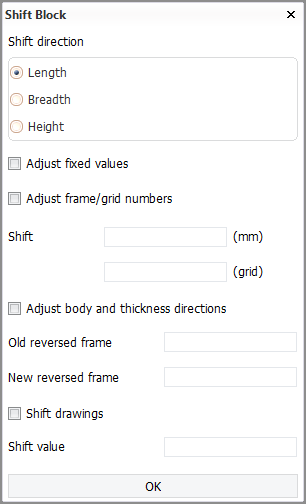Shift Block
With Tools > Shift Block it is possible to shift an entire block in an arbitrary direction. You can choose what values should be modified.
If you select Adjust fixed values, all fixed values are changed by the amount entered in the upper field (mm). Shifting the fixed values of a block will result in a shift of all coordinates in a block. Grid and frame relations will not changed only fixed values relations in mm and yellow menu lines will be changed.
If you select Adjust frame/grid numbers, then also frame/grid numbers in the relation database are adjusted by the amount entered in the lower input field (grid).
While shifting a block in length, plates and profiles can be shifted over the reversed frame. You can decide what should happen with body and thickness directions. You can either decide that nothing should happen or that the directions should change. If the directions should change, then you must provide old and new values for the reversed frame. These values are used in the following way: if a part is on one side of the Old reversed frame before shifting and on the other side of New reversed frame after shifting, then the direction will be adjusted. The two values can be different in the case of different frame coordinate lists before and after shifting.
Drawings and sheet drawings can be included in the shift action by selecting the option Shift drawings. The shift value can be defined in millimeters or by using grid values with an optional offset.

In situations where a block is shifted to a position in the ship that would change the construction in the block (when for example the shape of the hull is different at the new position), the construction should be recalculated, followed by the updating of all drawings.
In situations where more than one block needs to be shifted, every block should first be successfully shifted before recalculating construction and updating all drawings for each block.
See also: General rules.